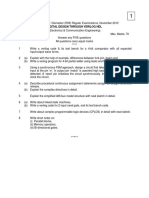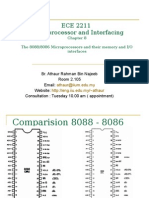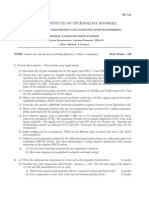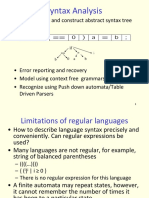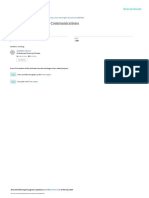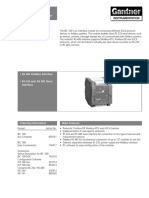Numerical Problems From Data Link Control (DLC) Layer
Uploaded by
Bhavya NagNumerical Problems From Data Link Control (DLC) Layer
Uploaded by
Bhavya NagNumerical Problems from Data Link Control (DLC) Layer
1. The following code vectors (101101, 110110 and 100011) are generated from a (6,3) parity check code. Find the
rule for generating each of the parity checks. What is the minimum distance of this code? What is the error
detection and correction capability of this code?
2. Frames of 1000 bits are sent over a 1 Mbps channel using a geostationary satellite whose propagation time from the
earth is 270 msec. Acknowledgements are always piggybacked onto data frames. The headers are very short. Three-
bit sequence numbers are used. What is the maximum achievable channel utilization for (a) stop-and-wait, (b) go-
back-n and (c) selective repeat ARQs.
3. Consider a (7,4) cyclic code generated by g(x) = x3 + x + 1. (i) Illustrate the encoding procedure with the message
vector 1101 using feedback shift register and verify with polynomial division using modulo-2 operations. (ii)
Illustrate the decoding procedure for the received code vector corresponding to the transmitted code vector in step
(i) with an error at 4th bit position and verify the same with polynomial division using modulo-2 operations.
4. Let Tmin be the minimum transmission time for data frames and Td be the propagation and processing delay in
each direction. Find the maximum allowable value Tmax for frame transmission time such that a go-back-n ARQ
system will never have to go back or wait in the following cases: (i) absence of transmission errors or lost frames
and (ii) isolated errors can occur in the feedback direction.
5. A channel has a bit rate of 4 kbps and a propagation delay of 20 msec. Find what range of frame sizes does stop-
and-wait ARQ give an efficiency of at least 50 percent?
6. The generator polynomial for a (15,7) cyclic code is g(x) = 1+x4 +x6 +x7 +x8 . Find the code vector (in systematic
form) for the message polynomial m(x) = x2 + x3 + x4 . Assume that the first and last bits of the code vector T (x)
for m(x) = x2 + x3 + x4 suffer transmission errors. Find the syndrome s(x) of the received code vector R(x).
(syndrome is the reminder obtained by dividing R(x) by g(x).)
7. Design an optimum selective repeat ARQ (optimize the buffer space) for the round trip delay of 40 ms and frame
transmission time of 1 ms. (i) What is the size of sender window and receiver window? (ii) How many bits are
required to represent sequence and request numbers? (iii) When the sender window will get exhaust (go back)? (iv)
What will be the frame error patterns (repeated frame error) to achieve the channel utilization of 50% and 25%?
8. The following code vectors (1011001, 1001110, and 1100101) are generated from a (7,4) parity check code. Find
the rule for generating each of the parity checks. What is the minimum distance of this code? What is the error
detection and correction capability of this code?
9. The generator polynomial for a (15,7) cyclic code is g(x) = 1+x4 +x6 +x7 +x8 . Find the code vector for the
message 0011100, and draw the encoder circuit for generating the parity bits.
10. If each packet carries 1000 bits of data, how long does it take to send 1 million bits of data using (i) stop and wait
ARQ, (ii) go-back-n ARQ and (iii) selective repeat ARQ. Assume that all three ARQs are using 3 bits for
representing sequence numbers. The distance between sender and receiver is 5000 Km and the propagation speed is
2 x 108 m? Ignore transmission, waiting and processing delays. Assume no data or control frame is lost or damaged.
11. Design an optimum selective repeat ARQ (optimize the buffer space) for the round trip delay of 40 ms and frame
transmission time of 1 ms. (i) What is the size of sender window and receiver window? (ii) How many bits are
required to represent sequence and request numbers? (iii) When the sender window will get exhaust (go back)? (iv)
What will be the frame error patterns (repeated frame error) to achieve the channel utilization of 50% and 25%?
You might also like
- Addressing Modes in 8085 - ComputerSC PDFNo ratings yetAddressing Modes in 8085 - ComputerSC PDF6 pages
- CHAPTER 6. Buses & Interfacing: Ec303 - Computer Architecture & OrganizationNo ratings yetCHAPTER 6. Buses & Interfacing: Ec303 - Computer Architecture & Organization17 pages
- EI6702-Logic and Distributed Control System PDF100% (1)EI6702-Logic and Distributed Control System PDF15 pages
- Bandwidth Utilization:: Solutions To Review Questions and ExercisesNo ratings yetBandwidth Utilization:: Solutions To Review Questions and Exercises6 pages
- Collision Free Protocol-Bit Map ProtocolNo ratings yetCollision Free Protocol-Bit Map Protocol9 pages
- Micro-Controller and Interfacing Exam PaperNo ratings yetMicro-Controller and Interfacing Exam Paper2 pages
- Lecture1 Chapter1 - Introduction To Digital SystemsNo ratings yetLecture1 Chapter1 - Introduction To Digital Systems47 pages
- Lab - 03 .: Singly Linked List and Its Applications: ObjectivesNo ratings yetLab - 03 .: Singly Linked List and Its Applications: Objectives8 pages
- Question Bank: Information Coding TechniquesNo ratings yetQuestion Bank: Information Coding Techniques10 pages
- DLD GTU Question Bank: Chapter-1 Binary SystemNo ratings yetDLD GTU Question Bank: Chapter-1 Binary System129 pages
- Unit I Embedded Computing: 2 Marks QuestionsNo ratings yetUnit I Embedded Computing: 2 Marks Questions28 pages
- Practical: 3 Aim: Implement Common Bus System of Four 4-Bit Register Using 2x4 Decoder and Three State Buffer67% (3)Practical: 3 Aim: Implement Common Bus System of Four 4-Bit Register Using 2x4 Decoder and Three State Buffer2 pages
- 9A04706 Digital Design Through Verilog HDL PDFNo ratings yet9A04706 Digital Design Through Verilog HDL PDF4 pages
- ECE 2211 Microprocessor and Interfacing: The 8088/8086 Microprocessors and Their Memory and I/O InterfacesNo ratings yetECE 2211 Microprocessor and Interfacing: The 8088/8086 Microprocessors and Their Memory and I/O Interfaces37 pages
- Advanced Computer Architecture-II - CS704 Power Point Slides Lecture 02No ratings yetAdvanced Computer Architecture-II - CS704 Power Point Slides Lecture 0244 pages
- 8255 (Programmable Peripheral Interface)No ratings yet8255 (Programmable Peripheral Interface)6 pages
- Cse-Vii-Advanced Computer Architectures (10CS74) - Assignment PDFNo ratings yetCse-Vii-Advanced Computer Architectures (10CS74) - Assignment PDF6 pages
- Computer Architecture and Organization Ch#2 ExamplesNo ratings yetComputer Architecture and Organization Ch#2 Examples6 pages
- Department of Computer Science and Engineering Introduction To Internet (IT30037)No ratings yetDepartment of Computer Science and Engineering Introduction To Internet (IT30037)7 pages
- Sample Questions to prepare for End Term ExamNo ratings yetSample Questions to prepare for End Term Exam9 pages
- Indian Institute of Technology Roorkee: Department of Electronics and Communication EngineeringNo ratings yetIndian Institute of Technology Roorkee: Department of Electronics and Communication Engineering2 pages
- (Sem. Vi) Even Theory Examination 2012-13: PAPER ID: 2474No ratings yet(Sem. Vi) Even Theory Examination 2012-13: PAPER ID: 24742 pages
- Numerical Problems From Medium Access Control (MAC) Layer100% (1)Numerical Problems From Medium Access Control (MAC) Layer1 page
- Numerical Problems From OSI Reference Model and Physical LayerNo ratings yetNumerical Problems From OSI Reference Model and Physical Layer2 pages
- Syntax Analysis: - Check Syntax and Construct Abstract Syntax TreeNo ratings yetSyntax Analysis: - Check Syntax and Construct Abstract Syntax Tree22 pages
- Aishwarya Hiremath - Verification Engineer 2No ratings yetAishwarya Hiremath - Verification Engineer 21 page
- A Novel PAPR Reduction Scheme For Polar-Coded OFDM SystemsNo ratings yetA Novel PAPR Reduction Scheme For Polar-Coded OFDM Systems4 pages
- SSL Stripping Technique DHCP Snooping and ARP Spoofing InspectionNo ratings yetSSL Stripping Technique DHCP Snooping and ARP Spoofing Inspection7 pages
- AWS Certified Solution Architect AssociateNo ratings yetAWS Certified Solution Architect Associate3 pages
- ComputerNetworksCommunicationsThirdEdition by Abdelfatah A TamimiNo ratings yetComputerNetworksCommunicationsThirdEdition by Abdelfatah A Tamimi557 pages
- Silent SMS Denial of Service (DoS) AttackNo ratings yetSilent SMS Denial of Service (DoS) Attack7 pages
- Wireshark Network Forensic Analysis TutorialNo ratings yetWireshark Network Forensic Analysis Tutorial36 pages
- Communication Engineering-Ec8395 Unit I Analog CommunicationNo ratings yetCommunication Engineering-Ec8395 Unit I Analog Communication111 pages
- AT Commands Examples: Examples For U-Blox GSM/GPRS ModulesNo ratings yetAT Commands Examples: Examples For U-Blox GSM/GPRS Modules25 pages





































